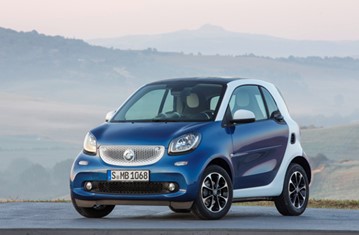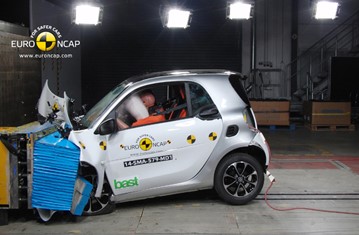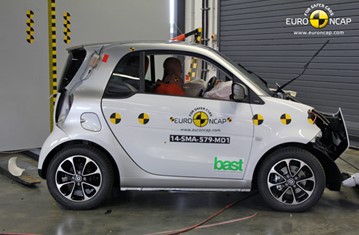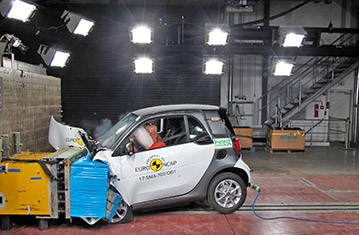Find more information in the General Comments section of the assessment
Find more information in the Rating Validity tab of the assessment
- See More
- See More
- See More
- See More
- Good
- Adequate
- Marginal
- Weak
- Poor
 Passenger
Passenger
 Driver
Driver
 Rear Seat
Rear Seat
 Front Seat
Front Seat
 Car
Car
 Pole
Pole
- Good
- Adequate
- Marginal
- Weak
- Poor
Passenger
Fitted to the vehicle as standard
Not fitted to the test vehicle but available as option
Not Available
-
Infants up to 13 kg
-
Infants and toddlers up to 18 kg
-
Toddlers from 9 to 18 kg
-
Toddlers over 18 kg
Easy
Difficult
Safety critical
Not allowed
| Seat Position | |
|---|---|
| Front | |
| Passenger | |
| Maxi Cosi Cabriofix (Belt) | |
| Britax Römer King Plus (Belt) | |
| Britax Römer Duo Plus (ISOFIX) | |
| Britax Römer KidFix (Belt) | |
| Maxi Cosi Cabriofix & EasyFix (Belt) | |
| Maxi Cosi Cabriofix & EasyFix (ISOFIX) | |
| BeSafe iZi Kid X3 ISOfix (ISOFIX) | |
| Maxi Cosi Pearl & Familyfix (ISOFIX) | |
| Britax Römer KidFix (ISOFIX) |
Easy
Difficult
Safety critical
Not allowed
As the fortwo is a two-seater, no dynamic tests were performed and the rating is based on the ease with which different restraints can be accommodated and on the provisions made in the vehicle for safe transportation of children. All of the child restraints which Euro NCAP uses to represent the broad range of types available could be properly installed and accommodated in the car. The passenger airbag can be disabled to allow a rearward-facing child restraint to be used in that seating position. Clear information is provided to the driver regarding the status of the airbag and the system was rewarded.
- Good
- Adequate
- Marginal
- Weak
- Poor

Head Impact 13.3 Pts
Pelvis Impact 1.2 Pts
Leg Impact 6.0 Pts
The bumper provided good protection to pedestrians' legs and scored maximum points. However, the protection offered to a pedestrian's pelvis by the front edge of the bonnet was predominantly poor. The bonnet surface offered predominantly marginal or weak levels of protection to a pedestrian's head, and poor results were recorded on the stiff windscreen pillars.
- Good
- Adequate
- Marginal
- Weak
- Poor
| Speed Limitation Function | Manually Set |
| System Name | ESP | |
| Performance | ||
| Applies To | Front seats | ||
| Warning | Driver Seat | Front Passenger(s) | Rear Passenger(s) |
| Visual | |||
| Audible | |||
|
|||
The fortwo has electronic stability control as standard equipment, together with a seatbelt reminder covering both seats. A driver-set speed limiter is available as an option and is expected to be fitted to most cars sold so was included in the assessment and met Euro NCAP's requirements for systems of this type. A lane departure warning system is also an option but it is expected that most cars will not be fitted with it so it was excluded from the assessment. An autonomous emergency braking system is not available on the fortwo.
- Specifications
- Safety Equipment
- Videos
- Rating Validity
Specifications
Tested Model smart fortwo 999cc petrol 'passion', LHD
Body Type - 2 door hatchback
Year Of Publication 2014
Kerb Weight 885kg
VIN From Which Rating Applies - smart fortwos, including cabrios and 'ed' variant, with safety specification tested
Class City and Supermini
Safety Equipment
Note: Other equipment may be available on the vehicle but was not considered in the test year.
Fitted to the vehicle as standard
Fitted to the vehicle as option
Not fitted to the test vehicle but available as option
Not Available
Not Applicable
Videos
Rating Validity








Find more information in the General Comments section of the assessment
Additional tests demonstrate that the 2014 star rating applies also to the electric 'ed' variant of the smart fortwo.
 Share
Share












The passenger compartment of the fortwo remained stable in the frontal impact. Dummy readings indicated good protection of the knees and femurs of both the driver and passenger. smart showed that a similar level of protection would be provided to occupants of different sizes and to those sat in different positions. In the side barrier test, protection of all body regions was good apart from the chest, protection of which was adequate. However, in the side pole test, dummy readings of rib compression revealed weak protection against chest injury. Euro NCAP observed also that the pole impactor came extremely close to striking the dummy's head. While the dummy readings did not indicate a head impact in this test, Euro NCAP has concerns over the robustness of protection provided by the current seat-mounted head/thorax airbag. Daimler have developed an optimised solution which will be introduced into production at the end of March 2015. The seats and head restraints provided good protection against whiplash injury in the event of a rear-end collision.